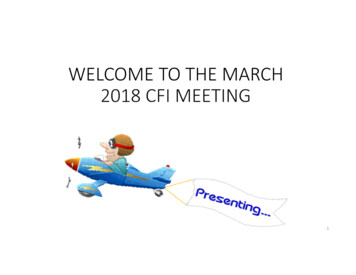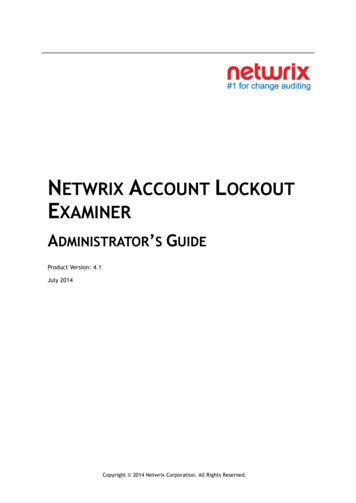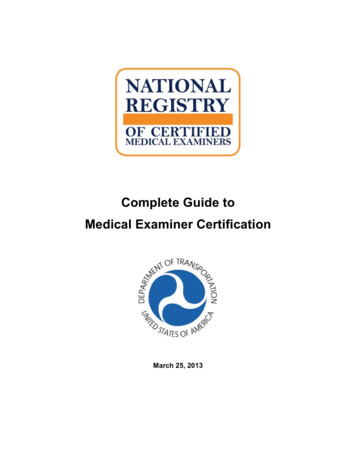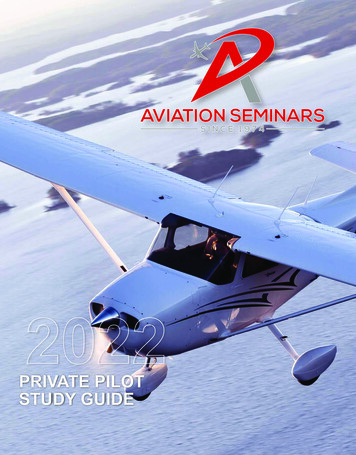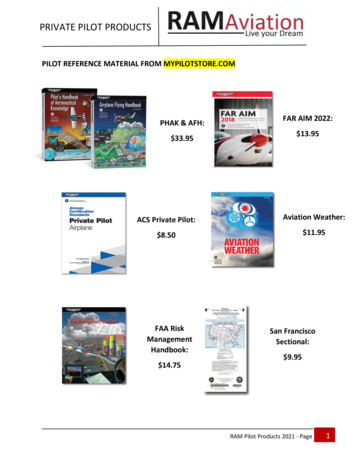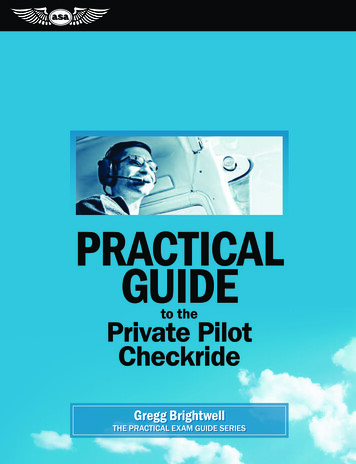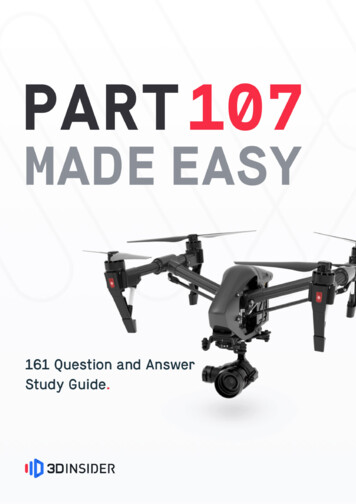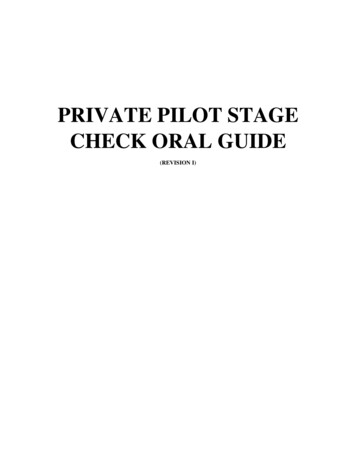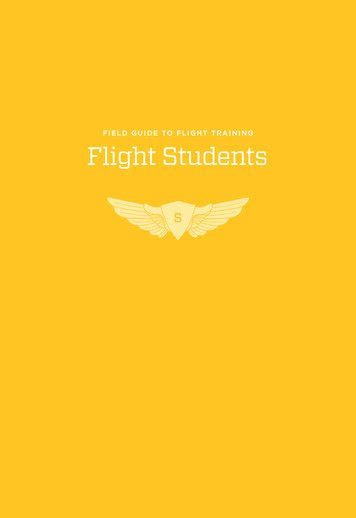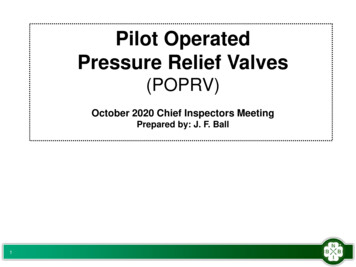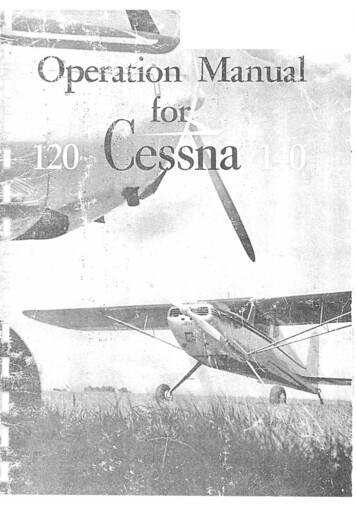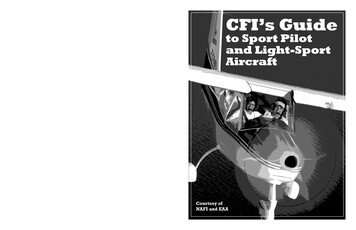
Transcription
CFI’s Guide to Sport Pilot and Light-Sport AircraftThe FAA regulations establishing the sport pilot certificate and lightsport aircraft have opened the sky to countless new pilots. Theseregulations gave birth to a new entry level to flying, with a means foryoung and old to involve themselves in recreational aviation. At thesame time, they created opportunities for flight instructors to becomeinvolved with both new and seasoned pilots.CFI’s Guideto Sport Pilotand Light-SportAircraftThe most distinct feature of this new entry level to aviation is accessibility. Previously, it took 40 hours of training to become eligible totake a practical test for a pilot certificate; the regulations now requireonly 20, which drops the cost to earn a pilot certificate by 50 percent!As costs diminish, more people will be free to consider taking upaviation. But, not all pilots who start off seeking a sport pilot certificate will stop at the sport pilot level. Many will want to add night flyingor instrument flying privileges or will want to fly larger aircraft. Sportpilot is an entry level for recreational aviation.The purpose of this Guide is to serve as a handy reference for thoseaviation educators currently certificated under Part 61, subpart H ofthe Federal Aviation Regulations (FARs), which has recently beenretitled Flight Instructors with Other Than a Sport Pilot Rating.P.O. Box 3086Oshkosh, WI EAACourtesy ofNAFI and EAA
Appendix 6Pilot Certificate Comparison - Airplane Category7 Steps to Teaching Sport Pilots1.2.3.4.5.6.7.Review the new Subpart J sport pilot rules.Review the Practical Test Standards (go towww.sportpilot.org).Locate a sport pilot-eligible aircraft for instruction.Inform your insurance company.Select or develop sport pilot training materials.Sign up to be listed on EAA’s Sport Pilot Instructor databaseat www.sportpilot.org.Check into DPE availability(go to www.sportpilot.org).Minimum Flight Experience-HoursFlight TimeDualDual Cross CountrySoloSolo Cross CountryNight FlightInstrument TrainingFlight Test PrepTestingKnowledge TestPractical TestMedicalSport Pilot2015251003Recreational Pilot3015230003Private Pilot40203105333YesYesDriver’slicense or 3rdclassYesYesYesYes3rd class3rd classPrivileges & LimitationsDayNightYesNoYesNoYesYesIFRNoNoYes, with instrument ratingVFR, greater than 3 miles visibilityVFR, less than 3 miles visibilityVFR above cloudsPassenger carriageYesNoNo1- passengerYesNoNo1- passengerDemonstrate aircraft as salespersonNoNoFly in furtherance of a businessNoNoTow UL hang glider or LSA gliderNoNoFly in charitable eventNoNoYesYesYesYes, no limitYes, with 200 hours totaltimeYesYes, with training andendorsementYesFlight in Class A airspaceNoNoYes, with instrument ratingYes, with additionaltraining andendorsementYesFlight in Class E and G airspaceYes, withadditionaltraining andendorsementYesFlight greater than 10,000 ft. MSLNoCross CountryYesType of airplaneLight-SportAircraftFlight in Class B, C, D airspaceFly airplane with VH faster than 87 knotsFly airplane with VH faster than 120 knotsYes, withtrainingendorsementNo12YesYesYes, if less than 2,000Yesft. AGLYes, with training andYesendorsement4 seats, 1 engine no Less than 12,500 lbs. maxmore than 180 hp, takeoff wt., higher wt. withfixed geartype ratingYesYesYesYes
CFI’s Guide to Sport Pilot and Light-Sport AircraftCFI’s Guide to Sport Pilot and Light-Sport Aircraft. 1Introduction. 1Overview . 1Sport Pilot Certificate . 1The Medical Issue . 2New Sport Pilots. 2Existing Pilots Operating as Sport Pilots, FAR 61.303 . 3Converting Ultralight Pilots. 4Registered Ultralight Pilot on or before September 1, 2004, FAR 61.329(a)(1). 4Registered UL Pilot After September 1, 2004, FAR 61.329(a)(2) . 4Light Sport Aircraft . 5Sport Pilot-Eligible Aircraft . 5Summary of a Sport Pilot-Eligible Airplane. 6Special Light-Sport Aircraft . 6Experimental Light-Sport Aircraft . 6Augmented Privileges . 7Controlled Airspace Endorsement, FAR 61.325 . 7VH of 87 Knots or Greater, FAR 61.327 . 7Aircraft Sets, FAR 61.323 . 7Category and Class: Proficiency Checks, FAR 61.321. 7Existing CFIs Operating at the Sport Pilot Instructor Level, FAR 61.429. 8Appendix 1 . 87 Steps to Teaching Sport Pilots. 8Appendix 2 . 8Student Pilot- Seeking a Sport Pilot Certificate - Endorsements . 8Appendix 3 . 9Sport Pilot Endorsements . 9Appendix 4 . 10Sets of Aircraft. 10Appendix 5 . 11Resources . 11EAA . 11NAFI . 11FAA . 11Appendix 6 . 12Pilot Certificate Comparison - Airplane Category . 12 Copyright 2006, Experimental Aircraft Association, Inc. All rights reserved.
CFI’s Guide to Sport Pilot and Light-Sport AircraftIntroductionThe FAA regulations establishing the sport pilot certificate and light-sport aircraft haveopened the sky to countless new pilots. These regulations gave birth to a new entrylevel to flying, with a means for young and old to involve themselves in recreationalaviation. At the same time, they created opportunities for flight instructors to becomeinvolved with both new and seasoned pilots.The most distinct feature of this new entry level to aviation is accessibility. Previously, ittook 40 hours of training to become eligible to take a practical test for a pilot certificate;the regulations now require only 20, which drops the cost to earn a pilot certificate by 50percent! As costs diminish, more people will be free to consider taking up aviation. Butnot all pilots who start off seeking a sport pilot certificate will stop at the sport pilot level.Many will want to add night flying or instrument flying privileges or will want to fly largeraircraft. Sport pilot is an entry level for recreational aviation.The purpose of this guide is to serve as a handy reference for those aviation educatorscurrently certificated under Part 61, subpart H of the Federal Aviation Regulations(FARs), which has recently been retitled Flight Instructors with Other Than a Sport PilotRating.OverviewThe essence of what has come to be called the sport pilot/light-sport aircraft (SP/LSA)rule is the addition to the FARs of two new Subparts: Subpart J, Sport Pilots and SubpartK, Instructors with a Sport Pilot Rating. The regulations can be confusing the first timeone reads them; this Guide will minimize that confusion.Because the vast majority of CFIs are familiar with airplanes, we will focus on airplanes.Sport pilots may also fly gliders, gyrocopters, balloons, airships, powered parachutes,and weight-shift-control aircraft. We will mention those less common aircraft inappropriate sections of the Guide, but our principal focus will be on airplanes.Important: One of the crucial things for a CFI to understand is that except inexceedingly rare circumstances YOU DON’T NEED ANY NEW CERTIFICATION TOTRAIN SPORT PILOTS. YOU ALREADY HAVE ALL THE NECESSARYQUALIFICATIONS. If your certificate permits you to instruct in single-engine airplanes,you’re all set to start. Of course, you need a tail-wheel endorsement to teach inconventional-gear aircraft, but ANY CURRENT CFI MAY TRAIN SPORT PILOTSWITHIN THE CATEGORY AND CLASS LIMITATIONS OF HIS CERTIFICATE.Sport Pilot CertificateUntil 2004, the FAA offered six different pilot certificates: student, recreational, private,commercial, airline transport, and flight instructor. The sport pilot certificate was createdto fill a gap between the student certificate and the recreational certificate. It gives theholder a well-defined set of privileges and carries an equally well-defined set oflimitations on its use. For a detailed comparison of the sport, recreational, and privatepilot certificates, see the chart inside the back cover.The privileges of a sport pilot certificate (FAR 61.315) allow one to: Operate as pilot in command of a sport-pilot eligible aircraft; Carry a passenger and share expenses (fuel, oil, airport expenses, and aircraftrental); Fly in airspace not requiring contact with air traffic control;1
Fly cross country;Fly in Class B, C, or D airspace with applicable training and logbookendorsement from an authorized instructor;Fly without an FAA medical certificate, provided the individual (1) has a currentand valid U.S. driver’s license; and (2) complies with all limitations on thatlicense.The limitations inherent in this certificate preclude one from operating an aircraft: Other than a light-sport aircraft; For hire or carrying passengers or cargo for hire; In the furtherance of business; Carrying more than one passenger; At night; In Class A airspace; Outside the United States (unless you have permission from the country inwhose airspace you wish to fly); In Class B, C, or D airspace without appropriate logbook endorsements; At an altitude above 10,000 feet MSL; When the flight or surface visibility is less than three statute miles or withoutvisual contact with the ground; While towing any object; In other circumstances set forth in FAR 61.315(c).It is also the general rule that any individual holding a recreational pilot certificate orhigher may exercise the privileges of a sport pilot certificate, provided the holdercomplies with the limitations of a sport pilot certificate. There are some exceptions tothis rule regarding flight in Class B, C, and D airspace, flight in different sets of aircraft,and flight in various categories and classes of aircraft. We will discuss these exceptionsbelow.The Medical IssueOne of the great benefits of the sport pilot rule is that it requires only a valid state driver’slicense to establish medical fitness. No more need for a third-class medical!Unfortunately, the rule includes one major exception: Existing pilots, including previousstudent pilots who have had their most recent FAA medical certificate applicationdenied, suspended, or revoked by the FAA, are not allowed to operate using theirdriver’s license. To qualify to use their valid state driver’s license, they must clear thedenial from their airman record by obtaining a valid third-class medical certificate. Anytime thereafter they may switch to using their driver’s license. Note that a specialissuance is not a denial.In addition, FAR 61.53 requires every pilot, from sport pilot to ATP, to self-certify medicalfitness to operate the aircraft in a safe manner before each flight. As pilots, it is ourresponsibility to ensure that our current medical health in no way jeopardizes the safetyof a flight.New Sport PilotsIndividuals seeking the sport pilot certificate as their initial pilot certificate must receivetraining, pass a knowledge test, and pass a practical test. One may obtain a sport pilotcertificate for the following categories and classes of aircraft:2
Sport Pilot FAR 61.313CategoryClassAirplaneSingle Engine Land/SeaWeight-shift controlLand/SeaPowered ParachuteLand/SeaRotorcraftGyroplaneGliderLighter Than Air (LTA)AirshipBalloonGround training must meet the requirements of FAR 61.309. The applicant for a sportpilot certificate must meet certain flight proficiency requirements, set forth in FAR61.311. The required aeronautical experience depends on the category and classprivileges sought by the applicant.Minimum flight experience is as d s20 hours20 hours12 hours20 hours10 hours7 hoursDual151510158Solo55252There are additional requirements for solo and cross-country flight, takeoffs, launches,landings, and preparation for the practical test. These requirements are set forth in atable in FAR 61.313.Training for the sport pilot certificate may take place in any aircraft. If the student has nomedical, however, solo flight is restricted to sport pilot-eligible aircraft. The practical testfor a sport pilot certificate must be taken in a sport pilot-eligible aircraft, as well. All sportpilot students must comply with Subpart C of FAR 61, which addresses pre-solo writtentests and endorsements, cross-country training and endorsements, and student pilotlimitations and restrictions.Existing Pilots Operating as Sport Pilots, FAR 61.303An individual holding a recreational pilot certificate or higher may exercise the privilegesof a sport pilot certificate, provided the holder complies with the privileges and limitationsof a sport pilot certificate. The main benefit of operating at the sport pilot level is that anycertificated pilot may fly without an FAA medical (see The Medical Issue section abovefor more information). Here’s all a pilot needs: A valid pilot certificate. Compliance with the medical requirements of a sport pilot. A current flight review (recorded in logbook). Fly a sport pilot-eligible aircraft. Operate within the privileges and limitations of the sport pilot certificate. Operate within the category/class ratings on the pilot certificate.An individual with a private, commercial, or ATP certificate may perform the flight reviewin any aircraft authorized by the person’s pilot certificate, assuming the CFI is pilot incommand.3
A private pilot choosing to operate at the sport pilot level need not do anything more thancomply with the rules. No change of certificates is necessary. If ramp checked, aprivate pilot may simply present the private pilot certificate and valid state driver’s licenseand inform the FAA inspector that you are operating as a sport pilot.Converting Ultralight PilotsRegistered Ultralight Pilot on or before September 1, 2004, FAR 61.329(a)(1)Ultralight (UL) pilots who registered with a training program offered by EAA, Aero SportsConnection (ASC), or the United States Ultralight Association (USUA) prior toSeptember 1, 2004, are provided an opportunity to convert to a sport pilot certificate nolater than January 31, 2007, by simply completing the following:1.2.3.Obtain a certified copy of their UL pilot training records.Pass the knowledge test.Pass the practical test.NOTE: Registered UL pilots do NOT need an endorsement from a CFI to take either theknowledge test or the practical test. A certified copy of their UL training record is all thatis needed; no student pilot certificate is required. As a practical matter, however, astudent pilot certificate may be needed so that the UL pilot can fly hisregistered/certificated aircraft to the examiner. You may be approached by registeredUL pilots for training to meet the requirements of FAR 61 Subpart C, including a pre-solowritten test, solo endorsement, or cross-country endorsement.Registered UL Pilot After September 1, 2004, FAR 61.329(a)(2)The FAA has created an incentive for ultralight pilots to participate in industryestablished ultralight registration programs, such as the EAA ultralight pilot registrationprogram. The FAA-given incentive allows ultralight pilots who have registered asultralight pilots with EAA, ASC, or the USUA after September 1, 2004, to useaeronautical experience (flight hours) obtained in ultralight vehicles (no FAA N-number)to meet the experience requirements to obtain a sport pilot certificate in accordance withFAR 61.52. Simply stated, this means a person could use time flown in an ultralightvehicle to meet the sport pilot certificate hourly experience requirement.For example, the 20 hours flight experience required for sport pilot airplanes could all beflown in an ultralight vehicle. However, the flight time must be properly logged per FAArequirements for logging flight time. Any flight instruction this ultralight pilot has had froman ultralight flight instructor should also be properly logged and endorsed by theultralight flight instructor in the same way an FAA CFI would endorse a student logbookafter a flight lesson. This flight instruction received from an ultralight flight instructor canbe used to meet the flight proficiency requirements specified in FAR 61.311. To verifycandidates were registered ultralight pilots, they need to get a copy of their certifiedultralight training records from the organization with whom they are registered.These post-September 1, 2004, registered ultralight pilots must, however, obtain FAAflight instructor endorsements prior to taking the required FAA knowledge and practicaltests in accordance with 61.307. Additionally, the endorsement for the practical testmust include 3 hours of flight training from an authorized instructor in the areas ofoperation specified in 61.311 within 60 days before the date of the practical test.4
Light-Sport AircraftSport Pilot-Eligible AircraftBecause of the operational freedoms, relaxed medical standards, and reduced trainingtimes accorded to sport pilots, the FAA has limited sport pilots to aircraft that are simpleto operate and easy to fly. The FAA accomplished this by defining light-sport aircraft(LSA) by performance characteristics. To be considered an LSA, an aircraft must havemet this definition continuously since its initial certification. If this is the case, it isconsidered sport pilot-eligible. An LSA is defined in FAR §1.1 as an aircraft, other than ahelicopter or powered-lift, that, since its original certification, has continued to meet thefollowing: A maximum takeoff weight of not more than-o 1,320 pounds (600 kilograms) for aircraft not intended for operation onwater; oro 1,430 pounds (650 kilograms) for an aircraft intended for operation onwater;o 660 pounds (300 kilograms) for lighter-than-air aircraft.A maximum airspeed in level flight with maximum continuous power (VH) of notmore than 120 knots (138 mph) CAS under standard atmospheric conditions atsea level.A maximum never-exceed speed (VNE) of not more than 120 knots (138 mph)CAS for a glider.A maximum stalling speed or minimum steady flight speed without the use of liftenhancing devices (VS1) of not more than 45 knots (51mph) CAS at the aircraft'smaximum certificated takeoff weight and most critical center of gravity.A maximum seating capacity of no more than two persons, including the pilot.A single, reciprocating engine, if powered.A fixed or ground-adjustable propeller if a powered aircraft other than a poweredglider.A fixed or autofeathering propeller system if a powered glider.A fixed-pitch, semi-rigid, teetering, two-blade rotor system, if a gyroplane.An unpressurized cabin, if equipped with a cabin.Fixed landing gear, except for an aircraft intended for operation on water or aglider.Fixed or repositionable landing gear, or a hull, for an aircraft intended foroperation on water.Fixed or retractable landing gear for a glider.So if the aircraft meets the above performance parameters, it is eligible to be flown by asport pilot. An aircraft meeting this definition may have a standard category,experimental amateur-built, experimental-LSA, or special-LSA airworthiness certificate.EAA prefers the term “sport pilot-eligible aircraft” to describe an aircraft that meets thedefinition of an LSA, no matter how it is certificated. We feel it is less confusing sincethe aircraft may not hold an airworthiness certificate that says LSA on it.5
Summary of a Sport Pilot-Eligible AirplaneSpecial Light-Sport AircraftThe FAA regulations also created a new airworthiness category: special light-sportaircraft (S-LSA). An S-LSA is a factory-built, ready-to-fly aircraft that has met ASTMconsensus standards for design, production, quality assurance, maintenance, andcontinuing airworthiness. An S-LSA may be rented to both students and rated pilots.They must be maintained and inspected by: (1) an FAA-certificated repairman with anLSA maintenance rating, (2) an A&P, or (3) an authorized repair station. Pilots who havereceived appropriate training may perform preventative maintenance on their S-LSA.100-hour inspections are required for any S-LSA used for compensation or hire.As of July 5, 2006, 30 new factory-built S-LSA airplane designs have been approved bythe FAA. To review a complete list of S-LSAs, go to EAA’s list at www.sportpilot.org andlook under “Aircraft”.NOTE: Operating limitations are issued as part of the airworthiness certificate for all SLSA aircraft. FAA-issued operating limitations are “mini regulations” that govern the useof that specific aircraft. It’s the responsibility of the pilot in command to operate theaircraft as allowed by the operating limitations. Do not confuse operating limitations withthe Pilot’s Operating Handbook (POH); they are entirely different and unrelateddocuments.Experimental Light-Sport AircraftAny ultralight may obtain a registration and airworthiness certificate to become an FAAcertificated aircraft. The FAA’s goal is to have all unregistered aircraft that do notcurrently meet the definition of a FAR Part 103 single-seat ultralight convert toexperimental light-sport aircraft (E-LSA) by January 31, 2008. Two-seat E-LSA areeligible to be used for hire for flight training through January 31, 2010.6
Augmented PrivilegesAmong the new concepts introduced in connection with the sport pilot rule is theaugmentation of a pilot’s privileges without direct FAA involvement. Several of thelimitations on the holder of a sport pilot certificate may be removed by obtainingappropriate training and a logbook endorsement from an authorized instructor.Advisory Circular 61-65E has been revised to include sport pilot endorsements. Wehave included all the appropriate sample endorsements in Appendix 2 and 3.Controlled Airspace Endorsement, FAR 61.325A sport pilot may gain authority to fly within Class B, C, or D airspace and within otherairspace controlled by a control tower, by receiving ground training, flight training, and alogbook endorsement from an authorized instructor. The appropriate endorsement isincluded in Appendix 3, #7.This is a one-time endorsement and need not be renewed. The endorsement may begranted to a student pilot as well, but special provisions set forth in FAR 61.94 and 61.95apply to student pilots.NOTE: Recreational pilots and higher are exempt from this endorsement per FAR61.303.VH of 87 Knots or Greater, FAR 61.327Another one-time endorsement is used to grant sport pilot privileges to fly as pilot incommand of an aircraft with VH greater than 87 knots calibrated airspeed (CAS). Theappropriate endorsement is included in Appendix 3, #8.NOTE: Recreational pilots and higher are exempt from this endorsement per FAR61.303.Aircraft Sets, FAR 61.323In addition to category and class, sport pilots are further limited by aircraft sets. A setconsists of aircraft sharing similar configuration and operating characteristics. SeeAppendix 4 for a list of FAA aircraft sets. For sport pilots to fly as pilot in command of anew set of aircraft, they must receive ground and flight training in a make and modelwithin the set, and a logbook endorsement from the authorized instructor who providedthe training. The appropriate endorsement is included in Appendix 3, #9.NOTE: Recreational pilots and higher are exempt from this endorsement, per FAR61.303.Category and Class: Proficiency Checks, FAR 61.321Perhaps the most radical change introduced with the SP/LSA rule is the method createdto permit a sport pilot to fly additional categories and classes of aircraft. Unlike otherpilot certificates, a sport pilot certificate carries no specification as to category or class;those details are handled by logbook endorsements rather than by certification.A pilot seeking to add a new category or class must first receive ground instruction andflight training from an authorized instructor, then pass a proficiency check with aninstructor other than the person who provided the training. The proficiency check mustbe conducted in compliance with the applicable Practical Test Standards published bythe FAA.7
The appropriate endorsement is included in Appendix 3, #4 & 5. For detailed guidanceon proficiency checks, consult the FAA’s website (see Appendix 5).Existing CFIs Operating at the Sport Pilot Instructor Level, FAR61.429One of the great benefits of the SP/LSA rule is that it allows flight instructors certificatedunder Subpart H—flight instructors who hold other than a sport pilot instructor rating—tooperate with the same medical requirements as a sport pilot (that is, a valid state driver’slicense) provided they limit their activity to that permitted an instructor certificated underSubpart K.Appendix 17 Steps to Teaching Sport Pilots1.2.3.4.5.6.7.Review the new Subpart J sport pilot rules.Review the Practical Test Standards (go to www.sportpilot.org).Locate a sport pilot-eligible aircraft for instruction.Inform your insurance company.Select or develop sport pilot training materials.Sign up to be listed on EAA’s Sport Pilot Instructor database atwww.sportpilot.org.Check into DPE availability (go to www.sportpilot.org).Appendix 2Student Pilot- Seeking a Sport Pilot Certificate - EndorsementsPrior to a local solo place in log book:1. Presolo aeronautical knowledge: § 61.87(b)I certify that (First name, MI, Last name) has satisfactorily completed the presoloknowledge exam of §61.87(b) for the (make and model aircraft).2. Presolo flight training: § 61.87(c)I certify that (First name, MI, Last name) has received the required presolo training in a(make and model aircraft). I have determined he/she has demonstrated the proficiencyof § 61.87(*) and is proficient to make solo flights in (make and model aircraft).* Use following letter for category of aircraft: (d) Airplane, (g) Gyroplane, (i) Glider, (J)Airship, (k) Balloon, (L) PPC or (m) WSC3. Solo flight (1st 90-day period): § 61.87(n)(2)I certify that (First name, MI, Last name) has received the required training to qualify forsolo flying. I have determined he/she meets the applicable requirements of § 61.87(n)and is proficient to make solo flights in (make and model).4. Solo flight (each additional 90-day period): § 61.87(p)(1)(v)I certify that (First name, MI, Last name) has received the required training to qualify forsolo flying. I have determined he/she meets the applicable requirements of § 61.87(p)and is proficient to make solo flights in (make and model).5. Solo takeoffs and landings at another airport within 25 NM: § 61.93(b)(1)I certify that (First name, MI, Last name) has received the required training of §61.93(b)(1). I have determined that he/she is proficient to practice solo takeoffs and8
landings at (airport name). The takeoffs and landings at (airport name) are subject to thefollowing conditions: (List any applicable conditions or limitations.)Prior to 1st cross-country solo place in logbook: (Instructor that did the training)6. Initial solo cross-countr
Flight Test Prep 3 3 3 Testing Knowledge Test Yes Yes Yes Practical Test Yes Yes Yes Medical Driver’s license or 3rd class 3rd class 3rd class . and private pilot certificates, see the chart inside the back cover. The privileges of a sport pilot certificate (FAR 61.315) allow one to: Operate as pilot
